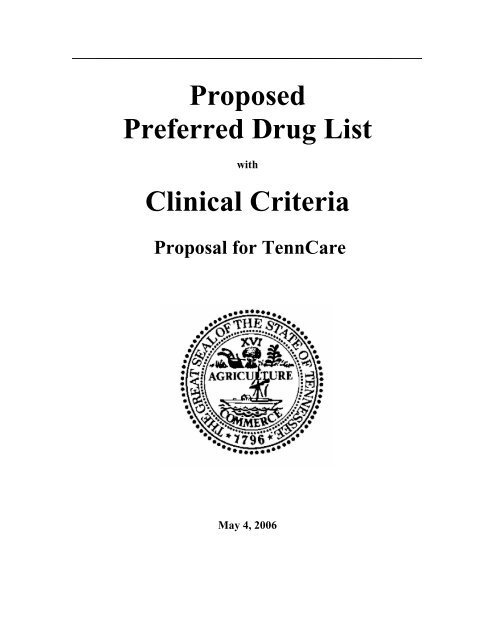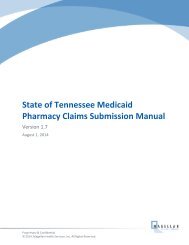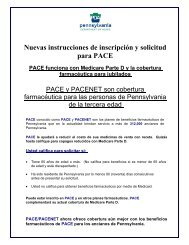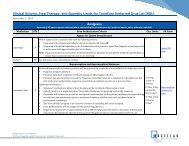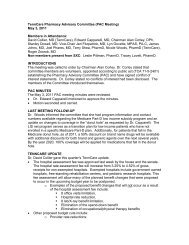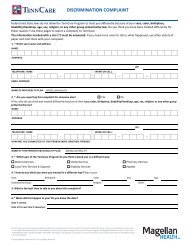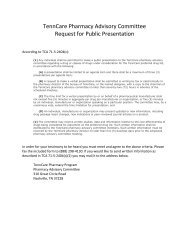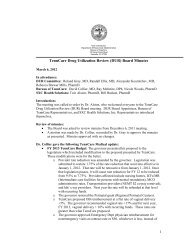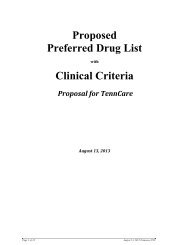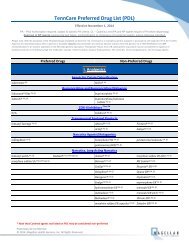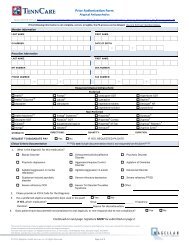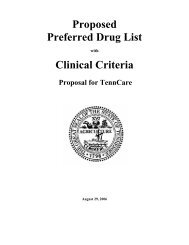Proposed Preferred Drug List Clinical Criteria - Magellan Health ...
Proposed Preferred Drug List Clinical Criteria - Magellan Health ...
Proposed Preferred Drug List Clinical Criteria - Magellan Health ...
You also want an ePaper? Increase the reach of your titles
YUMPU automatically turns print PDFs into web optimized ePapers that Google loves.
<strong>Proposed</strong><strong>Preferred</strong> <strong>Drug</strong> <strong>List</strong>with<strong>Clinical</strong> <strong>Criteria</strong>Proposal for TennCareMay 4, 2006
OPHTHALMIC AGENTSLENGTH OF AUTHORIZATIONS:1. Is there any reason the patient cannot be changed to a medication not requiringprior approval within the same class?Acceptable reasons include: Allergy to medications not requiring prior approval Contraindication to or drug-to-drug interaction with medications notrequiring prior approval History of unacceptable/toxic side effects to medications not requiring priorapproval2. The requested medication may be approved if both of the following are true: If there has been a therapeutic failure to no less than a one-month trial ofat least one medication within the same class not requiring prior approval The requested medications corresponding generic (if a generic is available andpreferred by the State) has been attempted and failed or is contraindicated3. The requested medication may be approved if the following is true: An indication which is unique to a non-preferred agent and is supported bypeer-reviewed literature or an FDA approved indication exists.Page 2
OPHTHALMIC AGENTSRE-REVIEW: OPHTHALMIC AGENTS: Anti-infectives - MiscPREFERREDNON-PREFERREDBACITRACIN ointment (compares to Aktracin®CHLOROPTIC® (chloramphenicol)AK-TRACIN® (bacitracin)CHLORAMPHENICOL drops and ointment CHLOROMYCETIN® (chloramphenicol)(compares to Chloroptic® and Chloromycetin® ILOTYCIN® (erythromycin)ERYTHROMYCIN ointment (compares toIlotycin®)RE-REVIEW: OPHTHALMIC AGENTS: Anti-infectives – Misc Combination ProductsPREFERREDNON-PREFERREDNEOMYCIN/POLYMYXIN/BACITRACIN NEOSPORIN® ointment (neomycin/polymyxin/bacitracin)ointment (compares to Neosporin® ointment) NEOSPORIN® solution (neomycin/polymyxin/gramicidin)NEOMYCIN/POLYMYXIN/GRAMICIDIN POLYSPORIN® ointment (bacitracin/polymyxin)solution (compares to Neosporin® solution) POLYTRIM® solution (polymyxin)BACITRACIN/POLYMYXIN ointment TERAK® with Polymyxin B (terramycin w/ polymyxin B)(compares to Polysporin® ointment)TERRAMYCIN w/POLYMYXIN B ointment(compares to Terak® with Polymyxin B)TRIMETHOPRIM SULFATE andPOLYMYXIN B solution (compares toPolytrim® ophthalmic)RE-REVIEW: OPHTHALMIC AGENTS: Anti-infectives - SulfonamidesPREFERREDNON-PREFERREDSulfacetamide 10% solution and ointment BLEPH-10® (sulfacetamide solution and ointment)(compares to Bleph-10®)RE-REVIEW: OPHTHALMIC AGENTS: Anti-infectives – Aminoglycosides andSteroid CombinationsPREFERREDNON-PREFERREDGENTAMYCIN solution and ointment GARAMYCIN® (gentamycin solution and ointment)(compares to Garamycin®)TOBREX® (tobramycin solution)PRED-G® ophthalmic suspensionTOBREX® (tobramycin ointment)(prednisolone/gentamicin) – no generic ZYLET® ophthalmic suspensionavailable(loteprednol/tobramycin) CC - no generic availableTOBRAMYCIN solution (compares toTobrex® solution)TOBRADEX® ophthalmic suspension(dexamethasone/tobramycin) no genericavailablePage 3
OPHTHALMIC AGENTSZYLET® CLINICAL CRITERIALength of Authorization: Six (6) monthsZylet® will be approved if the recipient has a contraindication to any two of the preferred ophthalmicsteroids or if there are concerns over a potential increase in intra-ocular pressure (IOP) with other steroids(i.e. glaucoma, recipient is pre or post cataract surgery and a known steroid-responder, etc.).ReferencesBiswas J, Ganeshbabu TM, Raghavendran SR, Raizada S, Mondkar SV, Madhavan HN. Efficacy and safety of 1% rimexolone versus1% prednisolone acetate in the treatment of anterior uveitis--a randomized triple masked study. Int Ophthalmol. 2004 May;25(3):147-53.Hirneiss C, Neubauer AS, Kampik A, Schonfeld CL. Comparison of prednisolone 1%, rimexolone 1% and ketorolac tromethamine0.5% after cataract extraction: a prospective, randomized, double-masked study. Graefes Arch Clin Exp Ophthalmol. 2005Aug;243(8):768-73. Epub 2005 Mar 9..McColgin AZ, Heier JS. Control of intraocular inflammation associated with cataract surgery. Curr Opin Ophthalmol. 2000Feb;11(1):3-6.Solomon KD, NSAIDS: Still a vital component of cataract surgery. Ophthalmology Management. March 2004NEW: OPHTHALMIC AGENTS: Anti-infectives – AntiviralsPREFERREDNON-PREFERREDTRIFLURIDINE (compares to Viroptic®) VIROPTIC® (trifluridine)NEW: OPHTHALMIC AGENTS: Anti-infectives – AntifungalsPREFERREDNON-PREFERREDNATACYN® (natamycin)RE-REVIEW: OPHTHALMIC AGENTS: Anti-infective-Steroid OintmentCombinationsPREFERREDNON-PREFERREDBACITRACIN/NEOMYCIN/POLYMYXIN- CORTISPORIN® ointmentB/HYDROCORTISONE ointment (compares (bacitracin/neomycin/polymyxin-B/hydrocortisone)to Cortisporin® ointment)MAXITROL® ointmentNEOMYCIN/POLYMYCIN/DEXAMETHAS (neomycin/polmyxin/dexamethasone)ONE ointment (compares to Maxitrol® PRED-G® S.O.P (prednisolone/gentamicin) – no genericointment)availableRE-REVIEW: OPHTHALMIC AGENTS: Anti-infective-Steroid Solution andSuspension CombinationsPREFERREDNON-PREFERREDNEOMYCIN/POLYMYXIN-CORTISPORIN® ophthalmic suspensionB/HYDROCORTISONE susp (compares to (neomycin/polymyxin-B/hydrocortisone)Cortisporin® susp)MAXITROL® ophthalmic suspensionNEOMYCIN/POLYMYCIN/DEXAMETHAS (dexamethasone/neomycin/polymyxin-B)ONE susp (compares to Maxitrol® susp) POLY-PRED® LIQUIFILM ophthalmic suspension(neomycin/polymyxin-B/prednisolone) – no genericavailablePage 4
OPHTHALMIC AGENTSRE-REVIEW: OPHTHALMIC AGENTS: Anti-infective - QuinolonesPREFERREDNON-PREFERREDCIPROFLOXACIN (compares to Ciloxan®) CILOXAN® (generic available)VIGAMOX® (moxifloxacin)OCUFLOX® (generic available)OFLOXACIN (compares to Ocuflox®)QUIXIN® (levofloxacin)ZYMAR® (gatifloxacin)RE-REVIEW: OPHTHALMIC AGENTS: Anti-infective-Steroid Solution,Suspension, and Sulfonamide CombinationsPREFERREDNON-PREFERREDPREDNISOLONE/SODIUMBLEPHAMIDE® S.O.P ointment (prednisoloneSULFACETAMIDE solution (compares to 0.2%/sodium sulfactemide 10% ointment) - no genericVasocidin® solution)availableBLEPHAMIDE® Susp (prednisolone 0.2%/sodiumsulfactemide 10% susp) - no generic availableFML-S® suspension (fluorometholone/sodiumsulfactemide)VASOCIDIN® (prednisolone 0.25%/sodiumsulfactemide 10% solution)NEW: OPHTHALMIC AGENTS: RX DecongestantsNON-PREFERREDPREFERREDNAPHAZOLINE 0.1% solution (compares toAlbalon®)PHENYLEPHRINE 2.5%, 20% solution(compares to Neo-Synephrine solution)ALBALON® (naphazoline 0.1%ophthalmic solution)NEO-SYNEPHRINE® (phenylephrine 2.5%, 20% ophth.solution)RE-REVIEW: OPHTHALMIC AGENTS: AntihistaminesPREFERREDNON-PREFERREDELESTAT® (epinastine)EMADINE® (emedastine)ZADITOR® (ketotifen)LIVOSTIN® (levocabastine)OPTIVAR® (azelastine)PATANOL® (olopatadine)Page 5
OPHTHALMIC AGENTSRE-REVIEW: OPHTHALMIC AGENTS: Mast Cell StabilizersPREFERREDNON-PREFERREDALOCRIL® (nedocromil)ALAMAST® (pemirolast)CROMOLYN SODIUM (compares to ALOMIDE® (lodoxamide)Crolom®/Opticrom®)CROLOM® (generic available)OPTICROM® (generic available)NEW: OPHTHALMIC AGENTS: Anti-inflammatory Steroid Solutions andSuspensionsPREFERREDNON-PREFERREDDEXAMETHASONE sodium phosphate ALREX® suspension (loteprednol 0.2%) CC - no genericsolution and ointment (compares toavailableDecadron®)FLUOROMETHOLONE suspension andointment (compares to FML® suspension andointment)PREDNISOLONE ACETATE suspension(compares to Econopred Plus®, Pred Forte®)PREDNISOLONE SODIUM PHOSPHATE(compares to Inflamase® 1% solution)DECADRON® (dexamethasone sodium phosphatesolution and ointment)FLAREX® suspension (fluorometholone)FML® suspension and ointment (fluorometholone)ECONOPRED® Plus® susp (prednisolone acetate 1%susp)INFLAMASE® (prednisolone sodium phosphate solution1% - generic available and 0.125% - no generic available)MAXIDEX® (dexamethasone suspension) - no genericavailableLOTEMAX® suspension (loteprednol 0.5%) CCPRED FORTE® susp (prednisolone acetate 1% susp)PRED MILD® (prednisolone acetate 0.12% susp – nogeneric available)VEXOL® suspension (rimexolone) CC - no genericavailableALREX® (loteprednol 0.2%), LOTEMAX® (lotepredol 0.5%) and VEXOL® (rimexolone)CLINICAL CRITERIALength of Authorization: Six (6) monthsAlrex®, Lotemax® and Vexol® will be approved if the recipient has a contraindication to any two of thepreferred ophthalmic steroids or if there are concerns over a potential increase in intra-ocular pressure(IOP) with other steroids (i.e. glaucoma, recipient is pre or post cataract surgery and a known steroidresponder,etc.).ReferencesBiswas J, Ganeshbabu TM, Raghavendran SR, Raizada S, Mondkar SV, Madhavan HN. Efficacy and safety of 1% rimexolone versus1% prednisolone acetate in the treatment of anterior uveitis--a randomized triple masked study. Int Ophthalmol. 2004 May;25(3):147-53.Hirneiss C, Neubauer AS, Kampik A, Schonfeld CL. Comparison of prednisolone 1%, rimexolone 1% and ketorolac tromethamine0.5% after cataract extraction: a prospective, randomized, double-masked study. Graefes Arch Clin Exp Ophthalmol. 2005Aug;243(8):768-73. Epub 2005 Mar 9..McColgin AZ, Heier JS. Control of intraocular inflammation associated with cataract surgery. Curr Opin Ophthalmol. 2000Feb;11(1):3-6.Solomon KD, NSAIDS: Still a vital component of cataract surgery. Ophthalmology Management. March 2004Page 6
OPHTHALMIC AGENTSNEW: OPHTHALMIC AGENTS: Anti-inflammatory: Non-Steroidal Antiinflammatory<strong>Drug</strong>s (NSAIDs)CLASS STPREFERREDNON-PREFERREDACULAR® (ketorolac) STNEVANAC® (nepafenac) STACULAR PF® (ketorolac) STOCUFEN® (flurbiprofen) STACULAR LS® (ketorolac) STVOLTAREN® (diclofenac) STDICLOFENAC (compares to Voltaren®) ST XIBROM® (bromfenac) STFLURBIPROFEN (compares to Ocufen®) STSTEP THERAPY CRITERIA for OPHTHALMIC NSAID USELength of Authorization : Six (6) monthsThe Ophthalmic NSAIDS as a class will be approved (preferred agents first and then non-preferred if thePDL criteria is met) if the recipient has a contraindication to any two of the preferred ophthalmic steroidsor if there are concerns over a potential increase in intra-ocular pressure (IOP) with other steroids ( ieglaucoma, recipient is pre/post cataract surgery and potential increases in IOP would place the recipient atrisk etc) or if the combination of ophthalmic steroid and NSAID is needed to control inflammation.ReferencesBiswas J, Ganeshbabu TM, Raghavendran SR, Raizada S, Mondkar SV, Madhavan HN. Efficacy and safety of 1% rimexolone versus1% prednisolone acetate in the treatment of anterior uveitis--a randomized triple masked study. Int Ophthalmol. 2004 May;25(3):147-53.Hirneiss C, Neubauer AS, Kampik A, Schonfeld CL. Comparison of prednisolone 1%, rimexolone 1% and ketorolac tromethamine0.5% after cataract extraction: a prospective, randomized, double-masked study. Graefes Arch Clin Exp Ophthalmol. 2005Aug;243(8):768-73. Epub 2005 Mar 9..McColgin AZ, Heier JS. Control of intraocular inflammation associated with cataract surgery. Curr Opin Ophthalmol. 2000Feb;11(1):3-6.Solomon KD, NSAIDS: Still a vital component of cataract surgery. Ophthalmology Management. March 2004NEW: OPHTHALMIC AGENTS: Mydriatics and Mydriatic CombinationsPREFERREDNON-PREFERREDATROPINE SULFATE (compares to Isopto CYCLOGYL® (cyclopentolate 0.5%, 1% amd 2%)Atropine®ISOPTO ATROPINE® (atropine sulfate)CYCLOPENTOLATE (compares to Cyclogyl ISOPTO HYOSCINE® (scopolamine) - no generic1%)availableTROPICAMIDE (compares to Mydriacyl®) MYDRIACYL® (tropicamide)CYCLOGYL® (cyclopentolate)CYCLOMYDRIL (cyclopentolate and phenylephrine)Page 7
OPHTHALMIC AGENTSNEW: OPHTHALMIC AGENTS: Glaucoma Agents: Direct-Acting MioticsPREFERREDNON-PREFERREDCARBACHOL 3% (compares to Isopto® ISOPTO® CARBACHOL (carbachol) 0.75%, 1.5%,Carbachol)2.25%, 3%PILOCARPINE Solution (compares to ISOPTO® CARPINE (pilocarpine solution – allPilocar® and Piloptic®)available generically with the exception of the 0.25%strength)PILOCAR®PILOPINE HS ® 4% GEL (pilocarpine gel – no genericavailable)PILOPTIC® (pilocarpine solution)NEW: OPHTHALMIC AGENTS: Glaucoma Agents: SympathomimeticsPREFERREDNON-PREFERREDDIPIVEFRIN (Compares to Propine®) PROPINE® (dipivefrin)RE-REVIEW: OPHTHALMIC AGENTS: Glaucoma Agents: Alpha 2 Adrenergic AgentsPREFERREDNON-PREFERREDALPHAGAN P® (brimonidine tartrate) IOPDINE® (apraclonidine)RE-REVIEW: OPHTHALMIC AGENTS: Glaucoma Agents: Beta-BlockersPREFERREDNON-PREFERREDBETAXOLOL HCL (compares to Betoptic®) BETAGAN® (generic available)BETOPTIC S® (betaxolol 0.25%)BETIMOL® (timolol)CARTEOLOL HCL (compares to Ocupress®) BETOPTIC® (generic available)LEVOBUNOLOL HCL (compares to Akbeta ISTALOL® (timolol)METIPRANOLOL (compares to Optipranolol®) OCUPRESS® (generic available)TIMOLOL MALEATE (compares toOPTIPRANOLOL® (generic available)Timoptic®/Timoptic-XE®)TIMOPTIC® (generic available)TIMOPTIC-XE® (generic available)RE-REVIEW: OPHTHALMIC AGENTS: Glaucoma Agents: Carbonic AnhydraseInhibitorsPREFERREDNON-PREFERREDAZOPT® (brinzolamide)COSOPT® (timolol maleate/dorzolamide)TRUSOPT® (dorzolamide)Page 8
OPHTHALMIC AGENTSRE-REVIEW: OPHTHALMIC AGENTS: Glaucoma Agents: Prostaglandin AgonistsPREFERREDNON-PREFERREDLUMIGAN® (bimatoprost)TRAVATAN® (travoprost)XALATAN®* (latanoprost)NEW: OPHTHALMIC AGENTS: Immunomodulators- Restasis®PREFERREDNON-PREFERREDRESTASIS® (cyclosporine) CCCLINICAL CRITERIA FOR RESTASIS® (cyclosporine)1. Appropriate Indicationsa. Treatment of moderate to severe keratoconjunctivitis sicca (KCS) in patients who havefailed at least 2 of the following therapies:1. Polyvinyl alcohol artificial tears drops or ointments administered at leastQID (ie Refresh® Tears)2. Carboxymethylcellulose (ie Celluvisc®) artificial tears or ointmentsadministered at least QID,3. Hydroxypropyl cellulose insert (Lacrisert®)4. Punctal plugs.b. Treatment of dry eyes in recipients with Sjogren’s disease will be an automatic approvalc. If the recipient is using the agent status post corneal transplant this will be an automaticapprovalPA Approval period: 1 yearNote: Cyclosporine ophthalmic emulsion will be discontinued if there is no improvement over priortherapies after 6 months of treatmentReferencesProduct information for Restasis. Allergan, Inc. Irvine CA 92623. February 2004.Barber, L.D.; Pflugfelder, S.C.; Tauber, J.; et. Al. Phase III Safety Evaluation of Cyclosporine 0.1% Ophthalmic EmulsionAdministered Twice Daily to Dry Eyes Disease Patients for Up to 3 Years. Opthalmology 2005; 112:(ePub ahead of print)Sall, K.; Stevenson, O.D.; Mundorf T.K.; Reis, B.L. Two Multicenter, Randomized Studies of the Efficacy and Safety of CyclosporineOphthalmic Emulsion in Moderate to Severe Dry Eye Disease. Opthalmology 2000; 107:631-639.Page 9
OTIC PRODUCTSNEW: OTIC AGENTS: Steroid and Antibiotic Combinations: Solutions and SuspensionsPREFERREDNON-PREFERREDHYDROCORTISONE/NEOMYCIN/POLYMYXIN- CORTISPORIN® OTIC solutionB solution (compares to Cortisporin® Otic soln.) (hydrocortisone/neomycin/polymyxin-B)HYDROCORTISONE/NEOMYCIN/POLYMYXIN- CORTISPORIN® OTIC/PEDIOTIC® suspensionB suspension (compares to Cortisporin®/Pediotic® (hydrocortisone /neomycin/polymyxin-B)Otic susp)COLY-MYCIN S-Otic susp(hydrocortisone/neomycin/colistin) - no genericavailableCORTISPORIN-TC Otic susp(hydrocortisone/colistin/thonzonium) - no genericavailablePREFERREDCIPRODEX® (ciprofloxacin/dexamethasonesuspension)NEW: OTIC AGENTS: QUINOLONESNON-PREFERREDCIPRO HC ® (ciprofloxacin/hydrocortisonesuspension)FLOXIN® (ofloxacin solution)PREFERREDACETIC ACID 2%, ALUMINUM ACETATE andBOROFAIR (compares to Otic Domeboro)CORTIC®, CORTIC®-ND, COTANE® B,TRI-OTIC® (compares to ZOTO® HC)BENZOCAINE/ANTIPYRINE combinations(compares to Allergen ear drops,Antipyrine/Benzocaine OticBENZOCAINE/ANTIPYRINE/OXYQUINOLINEcombinations (compares to Auroguard Otic, Otocain)BENZOCAINE/BENZETHOMIUM/GLYCERIN(Omedia, Oticaine - compares to Otocain®)NEW: OTIC AGENTS: MiscNON-PREFERREDACETASOL HC® solution (hydrocortisone/aceticacid)CORTANE-B® drops(hydrocortisone/pramoxine/chloroxylenol)HYDROCORTISONE/ACETIC ACID (compares toacetasol HC® solution)OTOCAIN® (benzocaine/benzthonium/glycerin)OTIC DOMEBORO (acetic acid)ZOTO-HC®(chloroxylenol/pramoxine/hydrocortisone)Page 10
DERMATOLOGICSLENGTH OF AUTHORIZATIONS:ONE YEAR-IF MEDICALLY JUSTIFIED.1. Is there any reason the patient cannot be changed to a medication not requiringprior approval within the same class?Acceptable reasons include: Allergy to medications not requiring prior approval Contraindication to or drug-to-drug interaction with medications notrequiring prior approval History of unacceptable/toxic side effects to medications not requiring priorapproval Recipient’s condition is clinically unstable-and changing to a medication notrequiring prior approval might cause deterioration of the recipient’s condition• Document clinically compelling information2. The requested medication may be approved if both of the following are true:• If there has been a therapeutic failure to no less than a one-month trial of atleast one medication within the same class not requiring priorapproval.Verify via the recipient’s medication history to assure medicationcompliance• The requested medications corresponding generic (if a generic is available andcovered by the State) has been attempted and failed or is contraindicated3. The requested medication may be approved if the following is true: An indication which is unique to a non-preferred agent and is supported bypeer-reviewed literature or an FDA approved indication exists.Page 11
DERMATOLOGICSPREFERREDNEW: DERMATOLOGICS: Antipruritic/Antihistamine AgentsNON-PREFERREDZONALON® (5% doxepin cream) CCPRUDOXIN® (5% doxepin cream) CC<strong>Proposed</strong> <strong>Clinical</strong> <strong>Criteria</strong> for Zonalon®/Prudoxin® - 5% doxepin cream1. Recipient must have the appropriate diagnosis:- Treament for moderate pruritis due to various forma of eczematous dermatitis including atopic dermatitis andlichen simplex chronicus2. Recipient must have an intolerance(s), contraindication(s) to or inadequate response(s) to at least two of thefollowing alternatives:- At least one other topical corticosteroid- At least one oral antihistamine (may be first or second generation) or one topical antihistaminic agent (ieDiphenydramine (Benadryl® OTC) topical creamNotes:- Zonalon®/Prudoxin® - 5% doxepin cream may be used in combination with a topical or oral corticosteroid inorder to relieve pruritis in order to reduce corticosteroid course of therapy- Zonalon®/Prudoxin® - 5% doxepin cream should not be used for greater than eight days so as greater usage hasbeen shown to result in higher systemic levels and increase the likelihood of contact sensitizationReferencesBonnel RA, La Grenade L, Karwoski CB, Beitz JG. Allergic contact dermatitis from topical doxepin: Food and <strong>Drug</strong> Administration’spostmarketing surveillance experience. J Am Acad Dermatol 2003:48;294-6Jones ME. Systemic adverse effects from topical doxepin cream. Ann Pharmacother 2001;35:505.Bioglan Pharmaceuticals Company. Zonalon Cream, 5% prescribing information. Malvern, PA: revised 12.20.2002.RE-REVIEW: DERMATOLOGICS: Topical AntiviralsPREFERREDNON-PREFERREDZOVIRAX® (acyclovir 5% ointment)DENAVIR® (peniclovir 1% cream)ZOVIRAX® (acyclovir 5% cream)NEW: DERMATOLOGICS: Topical Agents used for BurnsNON-PREFERREDPREFERREDSILVER SULFADIAZINE (compares to SSD®,Silvadene®NITROFURAZONE 0.2% ointment (compares toFuracin®)FURACIN® (nitrofuracin 0.2% cream and ointment)SULFAMYLON® (mafenide) – no generic availableSSD® (silver sulfadiazine)SILVADENE® (silver sulfadiazine)NEW: DERMATOLOGICS: Antiseborrheic AgentsNON-PREFERREDPREFERREDSELENIUM SULFIDE 2.5% lotion (compares toSelsum®)SULFACETAMIDE SODIUM 10% wash(compares to Ovace® Wash)CARMOL® 10% SCALP LOTION (sulfactamide10%/urea 10%)OVACE® Wash (sulfacetamide sodium 10% lotion)OVACE® FOAM (sulfacetamide sodium 10% foam)OVACE® CREAM (sulfacetamide sodium 10% cream)OVACE® GEL (sulfacetamide sodium gel 10%)ROSULA® NS PADS (sulfacetamide sodium 10%/Urea10%)SELSUM® (selenium sulfide 2.5% lotion)Page 12
DERMATOLOGICSPREFERREDGENTAMICINCENTANY (compares to Bactroban® 2%ointment)MUPIROCIN (compares to Bactroban® 2%ointment)NEW: DERMATOLOGICS: Antibiotic AgentsNON-PREFERREDBACTROBAN® 2% ointment (mupirocin)BACTROBAN® 2% cream (mupirocin)NEW: DERMATOLOGICS: Antibiotic Agents used for AcneNON-PREFERREDPREFERREDBENZOYL PEROXIDE 2 ½ WASH liquid, gelBENZOYL PEROXIDE 5%,10% WASH(compares to Benzac® AC WASH)BENZOYL PEROXIDE 5% ,10% lotion(compares to TRIAZ® lotion)BENZOYL PEROXIDE 5%,10% gel (compares toPanOxyl® 5, PanOxyl® 10)CLINDAMYCIN PHOSPHATE gel, lotion,solution 1%ERYTHROMYCIN 2% solution, gel, pledgets(compares to Eryderm®, A/T/S®)ERYTHROMYCIN-BENZOYL 5% gel (comparesto Benzamycin®)SODIUM SOLFACETAMIDE/SULFUR 5%sulfur, 10% sodium sulfacetamide lotion(comparesto Zetacet®)SODIUM SOLFACETAMIDE/SULFUR 5%sulfur, 10% sodium sulfacetamide cream(compares to Rosac® cream)AKNE-MYCIN® 2% ointment (erythromycin) – no genericA/T/S® 2% solution, gel (erythromycin)BENZAC® AC WASH (benzoyl peroxide liquid 5%,10%)BENZAMYCIN® 5% gel (erythromycin)BREVOXYL® CREAMY WASH (benzoyl peroxide liquid4%)- no genericBREVOXYL® CREAMY WASH (benzoyl peroxide liquid6%)- no genericBREVOXYL®-4 (4% gel benzoyl peroxide)BREVOXYL®-8 (8% gel benzoyl peroxide)CLEOCIN-T® 1% gel, lotion (clindamycin)CLINAC BPO (7% gel benzoyl peroxide)CLINDAGEL® 1% gel, lotion, solution (clindamycin)CLINDAMAX® 1% gel, lotion (clindamycin)DUAC®/BENZACLIN® gel 5% benzoyl peroxide 1%clindamycin – no genericERYDERM® 2% solution, gel (erythromycin)ERY PADS® 2% pledgets (erythromycin)EVOCLIN® 1% foam (clindamycin) - no genericPANOXYL® AQ (benzoyl peroxide)PANOXYL 5 ® (benzoyl peroxide gel 5%)ROSAC® cream (5% sulfur, 10% sodium sulfacetamidecream)SULFOXYL® REGULAR 5% benzoyl peroxide 2% sulfurlotion - no genericSULFOXYL® STRONG 10% benzoyl peroxide 5% sulfurlotion - no genericTRIAZ® (benzoyl peroxide lotion 3%,6%) - no genericTRIAZ® (benzoyl peroxide lotion 10%)TRIAZ® (benzoyl peroxide liquid 6%,9%) - no genericTRIAZ® (benzoyl peroxide gel 3%, 6%, 10%)ZACLIR (benzoyl peroxide lotion 4%, 8%) – no genericZETACET® (5% sulfur,10% sodium sulfacetamide) lotionZODERM® (benzoyl peroxide cleanser, cream, gel 4.5%,6.5%, 8.5%) – no genericPage 13
DERMATOLOGICSNEW: DERMATOLOGICS: Antifungal Combination AgentsNON-PREFERREDPREFERREDCLOTRIMAZOLE 1%/BETAMETHASONE0.05% DIPROPIONATE cream 0.05%/1%(compares to Lotrisone®TRIAMCINOLONE/NYSTATIN cream, ointment(compares to Mycolog-II®)LOTRISONE® (clotrimazole 1%/betamethasone 0.05%cream, lotion) – no generic for the lotionMYCOLOG-II® (0.1% triamcinolone/100,000 unitsnystatin cream and ointment)VUSION® (zinc oxide 15%/miconazole 0.25%) CCVUSION® CRITERIA1.Recipient must have a diagnosis of complicated diaper dermatitis2. Recipient must be four (4) weeks of age or olderCLASS STNEW: DERMATOLOGICS: TOPICAL ANTIPSORIATICSPREFERREDNON-PREFERREDANTHRALIN (compares to Psoriatec®) STDOVONEX® (calcipotriene) STPSORIATEC® (anthralin) STTACLONEX® calcipotriene 0.005% and betamethasoneO.O64% STTAZORAC® (tazarotene) STSTEP THERAPY CRITERIA for TOPICAL ANTIPSORIATICSPA Period: 1 yearFailure of, intolerance or contraindication to at least two topical steroidsNEW: DERMATOLOGICS: Treatment for Genital WartsPREFERREDPODOFILOX (compares to Condylox®)PODOBEN® RESIN (podophyllum resin)PODOCON-25® (podophyllum resin)PODODERM® (podophyllum resin)PA REQUIREDCONDYLOX® (podofilox)NEW: DERMATOLOGICS: Immunomodulators, Misc.PREFERREDALDARA® (imiquimod)PA REQUIREDPage 14
DERMATOLOGICSNEW: DERMATOLOGICS: EmollientsPREFERREDAMMONIUM LACTATE (compares to LAC-Hydrin®, LAClotion®)LACTIC ACID (compares to Lactinol®, Lactinol-E®)PA REQUIREDLAC-HYDRIN® (ammonium lactate)LACLOTION® (ammonium lactate)LACTINOL® (lactic acid)LACTINOL-E® (lactic acid)RE-REVIEW: DERMATOLOGICS: Topical Immunomodulators, CalcineurinInhibitorsPREFERREDELIDEL® (pimecrolimus) CCPROTOPIC® (tacrolimus) CCPA REQUIREDPROTOPIC AND ELIDEL criteriaPrior Authorization period: 3 monthsElidel® or Protopic® will be approved for patients meeting the following criteria:• Patient must have history of a therapeutic failure on a medium potency or higher potencycorticosteroid.o Note – For the face and groin area, treatment with a topical steroid is waived.• For Elidel®, the patient must have a diagnosis of mild to moderate Atopic Dermatitis and be ≥ 2 yearsof age.• For Protopic® 0.03%, the patient must have a diagnosis of moderate to severe Atopic Dermatitis and be≥ 2 years of age.• For Protopic® 0.1%, the patient must have a diagnosis of moderate to severe Atopic Dermatitis and be≥ 18 years of age.ReferencesElidel® prescribing information. Novartis. January 2006.Protopic® prescribing information. Astellas Pharma. January 2006.American Academy of Dermatology Association. Guidelines of care for atopic dermatitis. 2004 (updated 2006).Page 15
DERMATOLOGICSNEW: DERMATOLOGICS: Oral RetinoidsPREFERREDPA REQUIREDACCUTANE® (isotretinoin) CCAMNESTEEM® (isotretinoin) CCCLARAVIS® (isotretinoin) CCSOTRET® (isotretinoin) CCACCUTANE criteria• Prior Authorization period: 6 monthsPatients will be approved for isotretinoin if both the patient and physician have registered with the iPledgeprogram. (Registration with the program helps to ensure appropriate counseling has been provided to thepatient and proper procedures have been followed to with regards to the risks of use in women of childbearingage).ReferencesAccutane® (isotretinoin) prescribing information. Roche. Aug. 2005.https://www.ipledgeprogram.com/Documents/Roche%20PI.pdfNEW: DERMATOLOGICS: Topical Retinoids STPREFERREDAVITA® (tretinoin) STTRETINOIN (compares to Retin A) STPA REQUIREDDIFFERIN® (adapalene) STRETIN A® (tretinoin) STRETIN A MICRO® (tretinoin) STTAZORAC® (tazarotene) STTRETIN-X® (tretinoin) STTOPICAL RETINOID criteriaFor patients less than 31 years old, all claims for topical retinoids will adjudicate at POS.For patients 31 years of age and older, claims will be approved for the following diagnoses:• Keratosis follicularis - approved for 12 months.• Verruca plana - approved for 2 months.• Actinic keratosis for the prevention of future lesions - approved for 12 months.• Acne vulgaris, provided the patient has tried and failed at least two of the following:o Benzoyl peroxideo Salicylic acido Topical antibiotics (clindamycin, erythromycin, tetracycline)o Oral antibiotics (tetracycline, minocycline, erythromycin, doxycycline, SMP/TMX),o Azelaic acid,o Sulfur products.If the patient has tried and failed two of the above agents, PA will be approved for 12 months.Page 16
DERMATOLOGICSNEW: DERMATOLOGICS: Pediculocides/ScabicidesPREFERREDPERMETHRIN 5% (compares to Elimite®,Acticin®)PA REQUIREDACTICIN® (permethrin)ELIMITE® (permethrin)LINDANE® CCOVIDE® (malathion) STEURAX® (crotamiton) STOVIDE® and EURAX® <strong>Criteria</strong>:Prior Authorization period: 1 monthFor Ovide®:- The patient must have a diagnosis of lice infestation- The patient must have tried and failed at least one permethrin product (either OTC or prescription)For Eurax®:- The patient must have a diagnosis of scabies- The patient must have tried and failed at least one prescription permethrin productReferencesHarvard School of Public <strong>Health</strong>. Head lice information. Aug. 9, 2000.http://www.hsph.harvard.edu/headlice.html1996 Guidelines for Control of Scabies in Long Term Care Facilities. Maryland Department of <strong>Health</strong> and MentalHygiene. https://www.cha.state.md.us/edcp/guidelines/scabies96.html#treatLINDANE criteriaPrior Authorization period: 1 monthFor Lice infestation:- Patients must have tried and failed or be unable to tolerate all other approved therapies (permethrin andmalathion)- Not approved for premature infants or individuals with uncontrolled seizure disordersFor scabies:- Patients must have tried and failed or be unable to tolerate all other approved therapies (permethrin, andcrotamiton)- Not approved for premature infants or individuals with uncontrolled seizure disordersReferencesMICROMEDEXAssociation of Genitourinary Medicine. 2002. National guideline on the management of scabies.Page 17
DERMATOLOGICSLENGTH OF AUTHORIZATIONS:1 YEAR (unless otherwise specified)1. Is there any reason the patient cannot be changed to a medication notrequiring prior approval within the same class?Acceptable reasons include: Allergy to medications not requiring prior approval Contraindication to or drug-to-drug interaction with medications notrequiring prior approval History of unacceptable/toxic side effects to medications not requiring priorapproval2. The requested medication may be approved if both of the following are true: There has been a therapeutic failure to no less than a one-month trial ofat least two medication(s) within the same class not requiring prior approval. The requested medication’s corresponding generic (if a generic is availableand preferred by the State) has been attempted, failed, or iscontraindicated.3. The requested medication may be approved if the following is true: An indication which is unique to a non-preferred agent and is supported bypeer-reviewed literature or an FDA approved indication exists.Page 18
DERMATOLOGICSPREFERREDALCOMETASONE (compares to Aclovate®0.05% cream, ointment)AMCINONIDE (0.1% oint,cream,lotion comparesto Cyclocort®)BETAMETHASONE DIPROPIONATEAUGMENTED 0.05% OINTMENT (compares toDiprolene®BETAMETHASONE DIPROPIONATEAUGMENTED 0.05% CREAM (compares toDiprolene ® AFBETAMETHASONE DIPROPIONATE 0.05%cream ,ointment, lotion (compares to Diprosone®)BETAMETHASONE VALERATE 0.1%ointment, cream, lotion (compares to Beta-Val®)CAPEX® (0.01% fluocinolone shampoo)CLOBETASOL (compares to Temovate®,Cormax®, Embeline®)DERMA-SMOOTHE/FS® (0.01% fluocinoloneoil)DESONIDE oint, cream, lotion 0.05% (comparesto DesOwen®)DESOXIMETASONE (compares to Topicort®ointment, cream, gel)DIFLORASONE (compares to ApexiCon®,Maxiflor®, Psorcon E ®)FLUOCINOLONE 0.025% ointment, 0.01%cream, 0.01% solution (compares to Synalar®)FLUOCINONIDE 0.05%cream,ointment,solution,gel (compares to Lidex®and Lidex-E®)FLUTICASONE 0.05% cream,ointment (comparesto Cutivate®)HALOBETASOL 0.05% oint, cream (compares toUltravate®)HYDROCORTISONE ointment 0.25%, 0.5%, 1%(compares to Hycort®HYDROCORTISONE cream 0.5%, 1%, 2.5%(compares to Hytone®HYDROCORTISONE lotion 2.5% (compares toHytone®HYDROCORTISONE BUTYRATE 0.1%ointment, cream, solution(compares to Locoid®)HYDROCORTISONE VALERATE ointment andcream (compares to Westcort®)MOMETASONE FUROATE 0.1% cream,lotion(compares to Elocon®)TRIAMCINOLONE ointment, cream, lotion(compares to Kenalog®, Aristacort HP®)NEW: DERMATOLOGICS: Topical SteroidsPA REQUIREDACLOVATE® (0.05% aclometasone oint, cream)APEXICON® (0.05% cream,ointment diflorasone)ARISTACORT A®, ARISTACORT HP® (triamcinolonecream, ointment)BETA-VAL® (betamethasone 0.1%valerate ointment,cream, lotion)CARMOL HC® CREAM (hydrocortisone 1% cream)CLOBEX® (clobetasol 0.05% lotion, shampoo– nogeneric)CLODERM® (0.1% clocortolone cream- no generic)CORDRAN®, CORDRAN SP® (0.05% ointment, cream,lotion, tape, flurandrenolide- no generic available)CYCLOCORT® (amcinonide)CUTIVATE® (Fluticasone 0.05% cream, ointment)DERMATOP® 0.1% cream,ointment (prednicarbate) – nogenericDESOWEN® (desonide)DIPROLENE® (betamethasone dipropionate augmented0.05% ointment)DIPROLENE® AF (betamethasone dipropionateaugmented 0.05% cream)DIPROLENE 0.05% LOTION (betamethasonedipropionate)DIPROSONE® 0.05% cream and ointment (betamethasonedipropionate)ELOCON® (mometasone 0.1% cream,lotion)EMBELINE® (clobetasol 0.05% oint, cream)HALOG® oint,cream, solution 0.1% (halcinonide)HYOCORT® (hydrocortisone ointment)HYTONE® (hydrocortisone cream 1%, 2.5%, lotion 2.5%,KENALOG® (triamcinolone cream, ointment, lotion)LACTICARE® HC (hydrocortisone lotion 2.5%)LIDEX® /LIDEX-E ®0.05% fluocinonide cream,ointment, solution,gel)LOCOID® (hydrocortisone butyrate 0.1% ointment, 0.1%cream, 0.1% solution)LUXIQ® (betamethasone foam) – no genericMAXIFLOR® (0.05% cream,ointment diflorasone)OLUX® (clobetasol 0.05% foam – no generic)PANDEL® (hydrocortisone probutate) – no genericPSORCON E® (0.05% cream,ointment diflorasone)SYNALAR® (fluocinolone 0.025% ointment, 0.01%cream, 0.01% solution)TEMOVATE® (clobetasol 0.05% oint, cream)TEXACORT® (hydrocortisone solution 1%)TOPICORT® (desoximetasone ointment, cream, gel)ULTRAVATE® (halobetasol 0.5% oint, cream)VANOXIDE®-HC LOTION (hydrocortisone 0.5% lotion)– no genericWESTCORT® (hydrocortisone valerate 0.2%ointment,0.2% cream)Page 19
DERMATOLOGICSPREFERREDCICLPIROX (compares to Loprox® 0.77% creamand topical suspension)ECONAZOLE cream 1% (compares toSpectazole®)KETOCONAZOLE cream,shampoo 2%(Nizoral®)NYSTATIN cream,ointment, powderPENLAC® (ciclopirox 8% topical solution)NEW: DERMATOLOGICS: Antifungal AgentsPA REQUIREDERTACZO® (sertaconazole cream 2%) – no genericEXELDERM® (1% cream,solution sulconazole – nogeneric)LOPROX® (ciclopirox 0.77% cream)LOPROX® (ciclopirox 0.77% gel, 1% shampoo) – nogenericMENTAX® (butenafine 1% cream)MONISTAT-DERM® (miconazole 2% cream)MYCOSTATIN® (nystatin oint,cream,powder)NAFTIN® 1% cream, gel (naftin hcl- no generic)NIZORAL® (ketoconazole 2% cream)OXISTAT® (1% cream,lotion oxiconazole – no generic)SPECTAZOLE® (econazole 1% cream)NEW: DERMATOLOGICS: Enzyme Preparations and Wound Healing AgentsPREFERREDACCUZYME® (papain/urea)ALLANZYME® (papain/urea)ETHEZYME® (papain/urea)GLADASE® (papain/urea)GLADASE-C® (papain/urea/chlorophyllin)GRANULEX® (trypsin/balsam/castor oil)GRANULDERM® (trypsin/balsam/castor oil)KOVIA® (papain/urea)PAP-UREA® (papain/urea)REGRANEX® (becaplermin) CCSANTYL® (collagenase)TBC® (trypsin/balsam/castor oil)XENADERM® (trypsin/balsam/castor oil)PA REQUIREDALLANFIL® (papain/urea)PANAFIL OINTMENT® (papain/urea/chlorophyllin)ZIOX® (papain/urea)REGRANEX criteriaPrior Authorization period: 6 monthsRegranex will be approved only for patients having a diagnosis of lower extremity diabetic neuropathic ulcers.Page 20
DERMATOLOGICSNEW: DERMATOLOGICS: Keratolytic AgentsPREFERREDKERATOL® (urea)CEROVEL® (urea)UREAVANAMIDE® (urea)X-VIATE® (urea)KERALYT® (salicylic acid)ULTRALYTIC-2® (ammonium lactate/urea)PA REQUIREDCARMOL 40® (urea)RE 40® (urea)GORDO-UREA® (urea)GORDOFILM® (salicylic acid/lactic acid/collodion)KERALAC® (urea)U-KERA® (urea)UMECTA® (urea)UREALAC® (urea)SALEX® (salicylic acid)NEW: DERMATOLOGICS: Topical AnestheticsPREFERREDPA REQUIREDDIBUCAINE (compares to Nupercainal®) ANESTACON® (lidocaine)LIDOCAINE (compares to Xylocaine®)EMLA® (lidocaine/prilocaine)LIDOCAINE-HCLIDAMANTLE (lidocaine)LIDOCAINE/PRILOCAINE (compares to LIDAMANTLE-HC® (hydrocortisone acetate/lidocaine)EMLA®)LIDODERM® patch (lidocaine) CCLIDOCAINE VISCOUS (compares to Xylocaine® NUPERCAINAL® (dibucaine)viscous)PRAMASONE® 2.5% (hydrocortisone /pramoxine)LIDOMAR VISCOUS (lidocaine viscous) PONTOCAINE® (tetracaine)SENATEC-HC (hydrocortisone acetate/lidocaine) XYLOCAINE® (lidocaine)HC PRAMOXINEXYLOCAINE® VISCOUS (lidocaine viscous)PRAMOSONE® 1% (hydrocortisone /pramoxine) AMERICAINE® (benzocaine)TETRACAINE (compares to Pontocaine®) ANACAINE® (benzocaine)FLUORI-METHANE® (Trichloromonofluoromethane/dichlorodifluormethane)NOVACORT® (hydrocortisone acetate/pramoxine/aloepolysaccharide)ORASEP® (benzocaine/tannic acid/menthol/cetylpyridinium chloride)BUCALSEP® (benzocaine/zinc chloride/pine tar/cetylpyridinium chloride)GARYLIN® (pyrilamine maleate/EtOH/benzocaine/methylbenzethonium chloride)LIDODERM criteriaPrior Authorization period: 6 monthsLidoderm will be approved for patients with a diagnosis of postherpetic neuralgia who have tried and failed orhave a contraindication to at least one agent in ALL of the following classes:o Tricyclic antidepressantso Anticonvulsantso Serotonin Nor-epinephrine Reuptake InhibitorsReferences:Cauffield JS, et al. Treatment options in neuropathic pain. U.S, Pharmacist. 2000.http://www.uspharmacist.com/oldformat.asp?url=newlook/files/feat/jun00pain.htmPage 21
DERMATOLOGICSNEW: DERMATOLOGICS: Topical AntineoplasticsPREFERREDPANRETIN® (alitretinoin)TARGRETIN® (bexarotene)SOLARAZE® (diclofenac sodium)FLUOROURACILCARAC® (fluorouracil)EFFUDEX® 5% cream (fluorouracil)FLUOROPLEX® (fluorouracil)PA REQUIREDEFFUDEX® 2% solutionEFFUDEX® 5% solutionPage 22
UROLOGICSLENGTH OF AUTHORIZATIONS:1 YEAR (unless otherwise specified)1. Is there any reason the patient cannot be changed to a medication not requiringprior approval within the same class?Acceptable reasons include: Allergy to medications not requiring prior approval Contraindication to or drug-to-drug interaction with medications notrequiring prior approval History of unacceptable/toxic side effects to medications not requiring priorapproval2. The requested medication may be approved if both of the following are true: There has been a therapeutic failure to no less than a one-month trial ofat least two medication(s) within the same class not requiring prior approval. The requested medication’s corresponding generic (if a generic is availableand preferred by the State) has been attempted, failed, or iscontraindicated.3. The requested medication may be approved if the following is true: An indication which is unique to a non-preferred agent and is supported bypeer-reviewed literature or an FDA approved indication exists.NEW: UROLOGICS: Urinary pH ModifiersPREFERREDCITRIC ACID/SODIUM CITRATE (compares toBicitra)CYTRA-2® (citric acid/sodium citrate)CYTRA-3® (potassium citrate/sodium citrate)CITRA-K® (citric acid/potassium citrate)TRICITRATES® (potassium citrate/sodiumcitrate/citric acid)K-PHOS #2® (potassium acid phosphate /sodiumacid phosphate)K-PHOS MF® (potassium acid phosphate /sodiumacid phosphate)K-PHOS NEUTRAL® (dibasic sodium phosphate/monobasic potassium phosphate/monobasic sodiumphosphate)PHOSPHA NEUTRAL® (dibasic sodium phosphate/monobasic potassium phosphate/monobasic sodiumphosphate)URO-KP-NEUTRAL® (dibasic sodium phosphate/monobasic potassium phosphate/monobasic sodiumphosphate)PA REQUIREDBICITRA® (citric acid/sodium citrate)ORACIT® (citric acid/sodium citrate)POLYCITRA® (potassium citrate/sodium citrate/citric acid)POLYCITRA-K® (citric acid/potassium citrate)Polycitra-LC S/F® (potassium citrate/sodium citrate/citric acid)RENACIDIN® (magnesium carbonate/citric acid/gluconolactone)UROQUID ACID #2® (methanamine mandelate/potassiumphosphate)CITROLITH® (potassium citrate/sodium citrate)UROCIT-K® (potassium citrate)PEDAMETH® (racemethionine)Page 23
UROLOGICSNEW: UROLOGICS: Urinary AnalgesicsPREFERREDPHENAZOPYRIDINE (Compares to Pyridium®)PHENAZOPYRIDINE PLUS (Compares toPyridium Plus®)URELIEF PLUS® (phenzopyridine/hyoscyamine/butabarbital)PYRELLE HB® (phenzopyridine/hyoscyamine/butabarbital)TRELLIUM PLUS® (phenzopyridine/hyoscyamine/butabarbital)URODOL® (phenazopyridine)PA REQUIREDPYRIDIUM® (phenazopyridine)PYRIDIUM PLUS® (phenazopyridine)NEW: UROLOGICS: Kidney Stone AgentsPREFERREDCYSTAGON® (cysteamine bitartrate)THIOLA® (tiopronin)PA REQUIREDCALCIBIND® (cellulose sodium phosphate)STONEX® softgel (eucalyptus/bornyl/fenchone/pinenealpha-beta/camphene)Page 24
UROLOGICSRE-REVIEW: UROLOGICS: Urinary Tract AntispasmodicsPREFERREDOXYBUTYNIN (Compares to Ditropan®)DETROL LA® (tolterodine)ENABLEX® (darifenacin)FLAVOXATE (Compares to Urispas®)VESICARE® (solifenacin)PA REQUIREDDETROL® (tolterodine)OXYTROL® (oxybutynin)SANCTURA® (trospium)DITROPAN® (oxybutynin)DITROPAN XL® (oxybutynin)URISPAS® (flavoxate)RE_REVIEW: UROLOGICS: Non-Selective Alpha-BlockersPREFERREDDOXAZOSIN (Compares to Cardura®)PRAZOSIN (Compares to MiniPress®)TERAZOSIN (Compares to Hytrin®)PA REQUIREDCARDURA® (doxazosin)CARDURA XL (doxazosin extended-release)MINIPRESS ® (prazosin)HYTRIN® (terazosin)RE_REVIEW: UROLOGICS: Selective Alpha-BlockersPREFERREDUROXATRAL® (alfuzosin)FLOMAX® (tamsulosin)PA REQUIREDRE_REVIEW: UROLOGICS: 5-Alpha Reductase InhibitorsPREFERREDPROSCAR® (finasteride)PA REQUIREDAVODART® (dutasteride)Page 25


